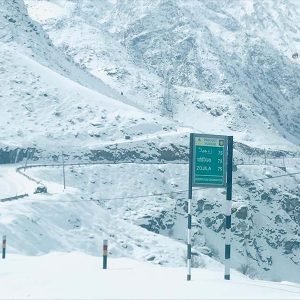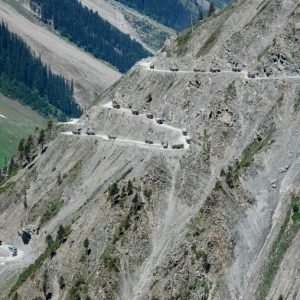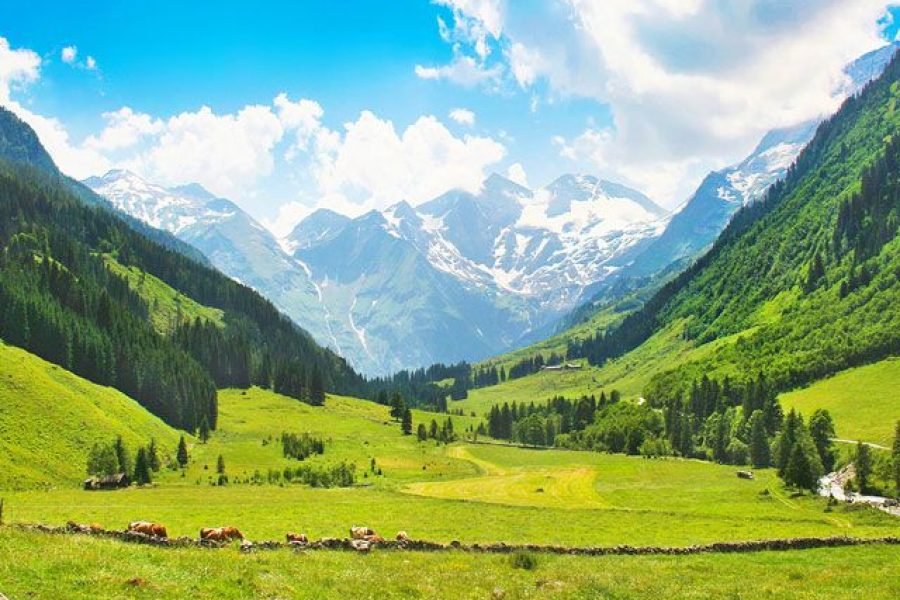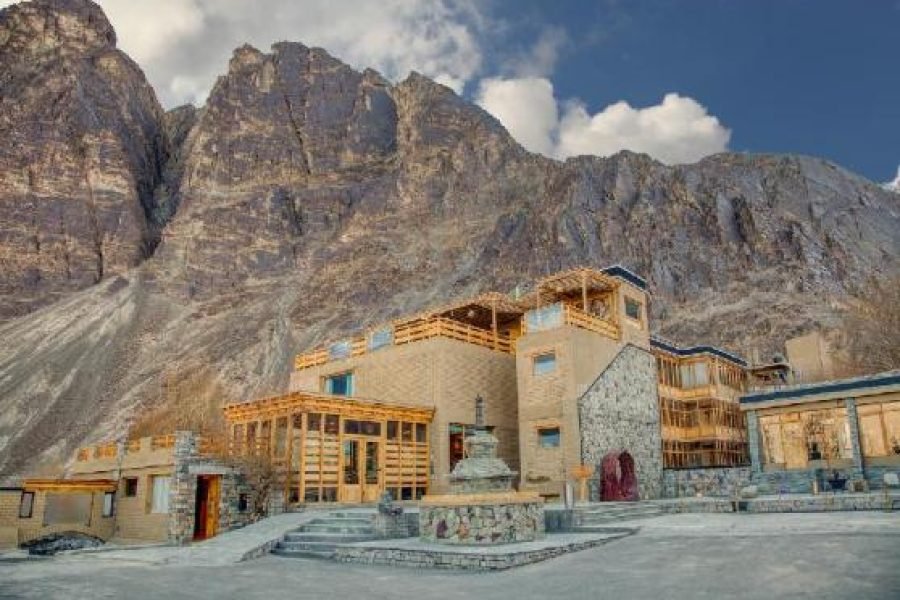Zoji La Pass : Gateway to the Frozen Frontier





Table of Contents
Toggle1. Introduction
Zoji La Pass, as more often spelt, Zojila or Zoji La, is an essential and beautiful mountain pass in the Indian Himalayas. It connects the Kashmir Valley with the cold desert of Ladakh. It lies about 3,528 meters above sea level, or 11,575 feet. Zoji La Pass plays a very important role for connecting Srinagar, the summer capital of Jammu and Kashmir, with Leh, the capital of Ladakh. This guide will give an idea about the place’s historical, geographical, and cultural importance and may also outline some information useful to travelers who would like to cross this hard-to-cross but breathtaking route.
2. Historical and Strategic Importance
Zoji La Pass has held historical and strategic importance since time immemorial. Since ancient times, it has served as a route for traders and travelers who used it on the journey between Kashmir and Central Asia. Its importance, however, increased manifold when India used the route during the 1947-48 Indo-Pak War for carriage of troops and supplies to defend Ladakh. During this operation, the pass was recaptured from the Pakistani forces by the Indian Army through its Operation Bison in 1948, marking a turning point of sorts in the war, and underlining the military significance of this axis.
Today, Zoji La remains an important military route, considering the need to keep Ladakh, with its vulnerable borders with China and Pakistan, integrated. The pass acts as an umbilical cord in carrying essential commodities, machinery, and defense supplies within the region, mainly during summer seasons when the pass is open. During winters, it is closed due to massive snowfall, hence severing the overland link between Kashmir and Ladakh for several months.
3. Geographical Features
Zoji La falls in the western part of the Himalayan Range, which is about 100 km from Srinagar and 350 km from Leh. This pass forms a dividing line between two sharply contrasted topographies. On one side, or rather in the west of the pass, lies the green, beautiful valley of Kashmir, which has a melee of meadows, lakes, and pine forests. While crossing Zoji La, travelers enter Ladakh, a cold desert with mountains that are usually bare, rugged, with scanty vegetation, and extreme whether conditions.
The pass itself is a narrow, twisting road that has been chiseled into steep mountain faces. At the high altitude, plus unpredictable weather, and missing correct barriers in some stretches, it counts among the most dangerous roads in the world. Not so hazardous but also capable of being quite an extraordinary vantage: lying amidst towering peaks, deep gorges, and shining rivers.
4. Climate and Road Conditions
The climate at Zoji La Pass varies from extremely harsh to being absolutely unforgiving. During summers, the temperatures range between 10°C and 20°C but because of the high altitude, the weather remains cool and brisk. Winters are extreme; the temperatures go as low as -30°C or even lower, with heavy snowfall that sometimes gathers several meters deep. During late autumn and early spring, the road is often quite hazardous due to snow, ice, and falling boulders.
The conditions of the road can be treacherous and quite hazardous to those sorts of vehicles that have never experienced mountain driving. Most of the pass consists of single-lane narrow roads, where there is little room for mistakes to happen. In fact, the sharp bends, steep gradients, and unpaved stretches create serious challenges for drivers and their vehicles alike. But the Indian Border Roads Organization does frequent work to maintain the pass and make it negotiable during the months that it is open.
Due to the harsh weather condition, Zoji La Pass remains closed during mid-November to mid-May. During the last few years, the construction of the Zoji La Tunnel and such other projects are in process for all-weather communication between Kashmir and Ladakh. This 14.2 km-long tunnel will ensure much easier and safer journey with the facility of avoiding the dangerous stretches of the pass.
5. Best Time to Visit Zoji La
The best time to go across or visit Zoji La Pass is during the months of June to September. During this time, the snow has considerably melted and opened up the road, and the weather, though chilling, is relatively stable. Summer months are thus quite favorable among the tourists who travel to have views of the beautiful landscapes comprising both Kashmir and Ladakh. However, these areas sometimes get affected by the monsoon rains, which block the way or sometimes cause landslides; therefore, a check on the weather forecast is better before setting off on a journey.
Early June is peculiar in that travelers can still envision patches of snow on the high peaks and around the pass-a sight to behold. By September, the skies are usually clear, providing unobstructed views of the surrounding landscape. This time of fall also changes the hues of the valley, with the leaves turning and giving a jarring contrast to stark Ladakh landscapes.
6. How to reach Zoji La Pass
Zoji La Pass can be approached either from Srinagar side or from the Leh side as per the direction of travel.
a. From Srinagar:
i. By Road: From Srinagar, it would take approximately 3-4 hours depending on the traffic situation and road conditions. It falls on National Highway 1, snaking right through scenic valleys and towns, notably the hill station of Sonamarg. The distance from Sonamarg to Zoji La Pass is about 23 km away.
ii. By Air: The nearest airport to Zoji La is in Srinagar, about 100 km away. From Srinagar, tourists can hire taxis or take buses to reach Zoji La Pass.
b. From Leh:
By Road: Zoji La is about 350 km away from Leh and takes about 8 to 10 hours of drive, depending upon road conditions. The route passes through the famous Magnetic Hill and the towns of Kargil and Drass are two most prominent stops on the way to the pass.
7. Things to Do Near Zoji La Pass
Though the pass is primarily a transit route, the area around the pass has some interest points for travelers:
a. Sonamarg: Also known as “Meadow of Gold,” it is a beautiful valley right before Zoji La. It is quite a favorite for trekking, camping, and river rafting during summer.
b. Kargil War Memorial: This is a memorial near the town of Drass, constructed in the memory of Indian soldiers who died during the Kargil War in 1999. The Kargil War Memorial is an important destination concerning India’s military history and hence a place worth visiting.
c. Baltal Base Camp: Baltal is a base camp for pilgrims to the Amarnath Cave, a revered shrine in Hinduism, which is situated close to the pass of Zoji La.
d. Drass Valley: Drass is the second coldest inhabited place on Earth. One can say that the scenic beauty and historical importance of Drass make it a remarkable stop for travelers.
8. Tips for Travelers
a. Permits: There is no need for any special permits to cross Zoji La by Indian citizens, while foreign nationals have to obtain an Inner Line Permit to enter Ladakh.
b. Vehicle Preparation: Ensure that your vehicle is in perfect condition to go on or over Zoji La. Carry spare tires, extra fuel, and other requirements because the services offered here are not adequate.
c. Altitude Sickness: Being at such a high altitude, it can give rise to AMS. It is advisable that proper acclimatization be done either at Srinagar or at Leh before crossing over Zoji La.
d. Accommodation and Food: There are some food and accommodation provisions at Sonamarg and Drass, but it is better if a portion of the snacks and water is carried along with you because nothing is available on the pass itself.
9. Conclusion
The Zozi La Pass is not a geographical feature; rather, it speaks volumes about resolute resistance and matchless perseverance. For the voyager of adventure, for the history buff that in search of the great military feats of India, and for whoever wants to witness miracles of nature, Zoji La stands unmatched. It needs to be tackled very cautiously out of respect, but owing to its aesthetic beauty and strategic importance, it stands out as one of the most interesting mountain passes anywhere in the world.
How to book a trip to Zoji La Pass, India with Charzan Holidays?
For a seamless and exceptional booking experience, contact Charzan Holidays at reservations@charzan.in or call us at +919622224473
Frequently Asked Questions
1. What is Zoji La Pass? | |
| Zoji La Pass is a mountain pass in the Indian Himalayas, connecting Srinagar and Leh. It is located at an elevation of 11,575 feet (3,528 meters) and is known for its stunning views and challenging terrain. | |
2. Where is Zoji La Pass located? | |
| Zoji La Pass is situated in the Kargil district of Ladakh, India, along the NH 1D highway. | |
3. When is the best time to visit Zoji La Pass? | |
| The best time to visit is between May and October when the pass is usually open and accessible. Winter months often see heavy snowfall, making it impassable. | |
4. How do I get to Zoji La Pass? | |
| You can reach Zoji La Pass by road from Srinagar or Leh. It’s commonly accessed by private vehicles, taxis, or through organized tours. | |
5. Is Zoji La Pass safe for travelers? | |
| While it is generally safe, travelers should be cautious of weather conditions, road quality, and altitude sickness due to the high elevation. | |
6. What should I pack for a trip to Zoji La Pass? | |
| Pack warm clothing, sturdy shoes, a first aid kit, snacks, water, and a good camera for the breathtaking views. | |
7. Are there accommodations near Zoji La Pass? | |
| There are limited accommodations in nearby areas like Sonamarg. It’s advisable to book in advance, especially during peak tourist season. | |
8. What kind of vehicles can traverse Zoji La Pass? | |
| 4×4 vehicles and well-maintained SUVs are recommended due to the rugged terrain. During peak season, local taxis also operate on this route. | |
9. Can I experience snow at Zoji La Pass? | |
| Yes, snow can be found at Zoji La Pass, especially during the early summer and late autumn months. However, heavy snowfall often blocks access during winter. | |
10. Are there any trekking opportunities near Zoji La Pass? | |
| Yes, several trekking routes start from or near Zoji La Pass, offering breathtaking views of the Himalayas and opportunities to explore local flora and fauna. | |
11. What is the altitude of Zoji La Pass? | |
| Zoji La Pass stands at an altitude of approximately 11,575 feet (3,528 meters) above sea level. | |
12. Are there any restrictions for travelers at Zoji La Pass? | |
| Travelers should check for any specific restrictions or permits required, especially due to its proximity to border areas. | |
13. What are the main attractions near Zoji La Pass? | |
| Nearby attractions include Sonamarg, Thajiwas Glacier, and various scenic viewpoints along the route. | |
14. Is there mobile network coverage at Zoji La Pass? | |
| Mobile network coverage may be limited in the pass area, so it’s advisable to inform someone about your travel plans in advance. | |
15. What precautions should I take when visiting Zoji La Pass? | |
| Acclimatize to the altitude gradually, stay hydrated, avoid strenuous activities, and travel with a companion if possible. Always check weather conditions before heading out. |









0 Comment